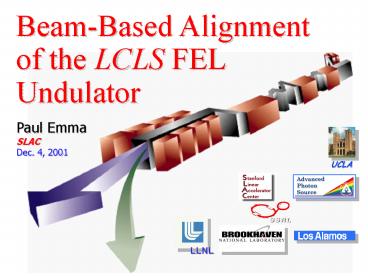BeamBased Alignment of the LCLS FEL Undulator - PowerPoint PPT Presentation
1 / 31
Title:
BeamBased Alignment of the LCLS FEL Undulator
Description:
1-mm BPM cavity and button-type in compact package (G. Decker, ANL) ... Need good overlap of e-/photon beam (30 mm rms) ... to within 1 mm (or use coils) ... – PowerPoint PPT presentation
Number of Views:140
Avg rating:3.0/5.0
Title: BeamBased Alignment of the LCLS FEL Undulator
1
Beam-Based Alignment of the LCLS FEL Undulator
Paul Emma SLAC Dec. 4, 2001
2
Beam-Based Alignment of the LCLS FEL Undulator
- LCLS introduction
- Undulator design
- Alignment motivation
- Alignment method
- Steps used in procedure
- Errors used in simulations
- Simulation results
- Summary
BBA used at TTF-FEL DESY (P. Castro, et. al.)
3
Linac Coherent Light Source (LCLS)
4th-Generation X-ray SASE FEL Based on SLAC Linac
4
Peak brightness increased 108 over existing
sources
?105 by FEL gain
?103 by improved beam quality, long undulators
courtesy J. Roßbach
5
Undulator (ANL/APS)
1-mm BPM ? cavity and button-type in compact
package (G. Decker, ANL)
Quad-magnets and undulator sections on
independent movers
6
LCLS 9-Pole Prototype Undulator (ANL)
3.4-m section is under construction at ANL
Courtesy E. Gluskin, ANL
7
FODO Lattice with ??? ? 18 m
- 32 undulator sections, L 3.4 m
- gt4000 undulator periods (3 cm)
- Permanent magnet quadrupoles
- 15º b-phase adv./cell, ????18 m
- Magnet movers on each quad (x,y)
- Movers on each undulator section
- 1-mm BPM at each quad (x,y)
- Quads aligned w.r.t. adjacent undulator sections
to lt50 mm
8
Alignment Motivation
- Need good overlap of e-/photon beam (30 mm rms)
- With 1.5-Å radiation, phase slippage between
photons and e- is very sensitive to trajectory
errors - The e- trajectory through the undulator needs to
be straight to lt5 mm over a 10-m FEL gain length - This level is difficult to achieve with survey
methods - LCLS will, therefore, rely on beam-based alignment
9
The Basic Strategy
- Take beam position monitor (BPM) readings as a
function of large, deliberate changes in e-
energy - Calculate and correct quadrupole BPM
misalignments and adjust initial trajectory
launch - Repeat 3 times with first application
- Re-apply one iteration per month (?)
10
The Method
- BPM readings, mi, written as sum of upstream
kicks offset, bi
- Kicks (? BPM reading) are sensitive to momentum,
pk, while offsets , bi, are not
11
mi
linear only if Cij independent of p
offset -bi
1/p
p??
(15 GeV/c)-1
(10 GeV/c)-1
(5 GeV/c)-1
- Reference line defined by incoming x0, x?0 launch
conditions
12
- For thick lens quadrupole, define
where Q j is the transfer matrix across the jth
quad, and R ji is the transfer matrix from end of
jth quad to ith BPM, all evaluated at kth
momentum setting, pk.
- Then solve
BPM readings at p1
BPM offsets
BPM readings at p2
quad offsets
known optical functions at each pk
13
- Must solve this system with soft-constraints
placed on the resulting BPM and quadrupole offsets
1 mm
- Without this reasonability weighting, the
resulting BPM and quad offset can stray out to
large values at low frequencies
- Scanning energy gives sensitivity to (and
correction of) all field errors, including
undulator poles, and Earths field, etc
C. Adolphsen, 1989 PAC
14
Schematic Layout
permanent magnet quadrupoles and undulator poles
suggested by C. Adolphsen
15
Beam-Based Alignment Steps
3
16
Undulator Parameters
3.42 m
undulator section
17
Input Errors for the Simulation
18
Initial BPM and Quad Misalignments (w.r.t. linac
axis)
Now launch beam through undulator?
19
Initial trajectory before any correction is
applied
Note, all trajectory plots are w.r.t. linac axis
(except last 3)
20
Trajectory after initial rough steering
Save as 1st set of BPM readings
21
Energy now reduced to 10 GeV
Save as 2nd set of BPM readings
22
Energy now reduced to 5 GeV
Save as 3rd set of BPM readings
23
Fitted quadrupole offsets
results differ by straight line
similar plot for BPM offsets (not shown)
use linear component of fitted offsets to
re-adjust launch
24
Absolute trajectory after 1st pass of BBA
25
Possible Absolute Trajectory
Beam is launched straight down undulator, with
possible inconsequential kink at boundary
LINAC
dispersion generated is insignificant
Now look at trajectory w.r.t. undulator axis ?
26
After 1st pass of BBA (now w.r.t. undulator line)
Now repeat procedure of energy changes
27
After 2nd pass of BBA
and repeat again
28
After 3rd pass of BBA
Dj ? 100
RON (FEL-code) simulation shows Lsat increased by
lt1 gain-length R. Dejus, N.Vinokurov
29
Electron/photon accumulated phase errors 3rd pass
of BBA
?x?y
?x
?y
Imperfect trajectory generates phase error 100º
(0.4-Å slippage)
30
Final quadrupole magnet mover settings after 3rd
pass BBA
31
Summary and Comments
Alignment can be achieved at adequate level using
beam-based technique, given that
- BPMs resolve trajectory at level of 1 mm rms
- BPM readings drift lt1 mm over a 1-2 hours
(temperature)
- Magnet movers are settable to within ?1 mm (or
use coils)
- BPM readings are not sensitive to variable beam
size, etc.
- Machine is stable enough in energy, charge,
trajectory,

